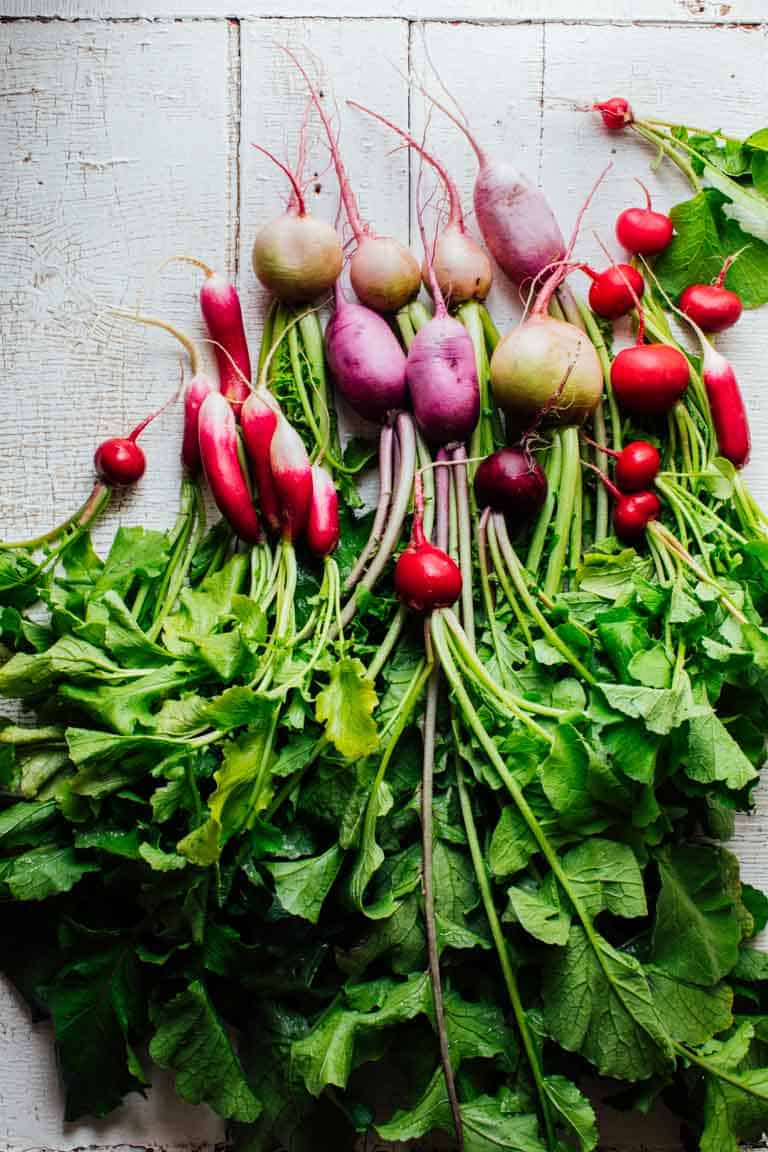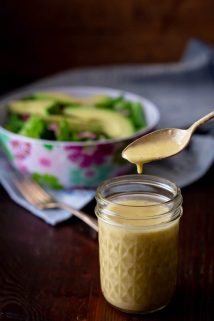Produce Spotlight: The Ultimate Guide To Radishes
In today’s Produce Spotlight, we will be covering everything you wanted to know about Radishes. Plus I have a brand new low-calorie side dish recipe made with radishes too: Simple Sautéed Radishes with Chives. Read on for the recipe and tips for back-yard gardeners on what kind of growing conditions they prefer, when to plant and when to pick them. Plus I also spoke with a Registered Dietitian about the health benefits of radishes. She answered questions about their starch too for those of you who are wondering if they are okay on a keto diet.

Table of contents
Radish Origin and Growing Information
The following information on the origin and growing of radishes was made possible by High Mowing Organic Seeds.
What are the different varieties of radishes?
Radishes come in hundreds of varieties. The types of radishes are usually subcategorized into Garden Radishes, Winter Radishes, and Daikon Radishes. Some break these down even further into French Breakfast-Type Radishes, Black or Spanish Radishes, and Watermelon-Type Radishes. Generally speaking, garden radishes are small and round (about 1” in diameter) and come in a variety of colors (red, pink, purple, white). French Breakfast radishes are a type of garden radish that grows slightly elongated, reaching about 2” long and ¾ inch across; they are usually red with a white tip. Winter radishes are larger and heartier than garden radishes, best for harvesting in the fall and storing through winter; Black/Spanish radishes and Watermelon radishes both are types of winter radishes. Daikon radishes are long instead of round, often reaching 6” or more in length. They are eaten raw less frequently than garden or winter varieties, usually being pickled or dried.
Where are radishes native to/ where did they originate?
Radishes are thought to have originated in Asia. As the cultivars spread, they also became popular with the Greeks and Romans.
Can radishes be started indoors?
Radishes do best when seeded directly into the ground, not started indoors for transplanting. Because the root is the part of the plant that is harvested, plants should not be disturbed by transplanting. Radishes are also extremely quick to mature, so starting indoors is not necessary to speed up maturity.
Can radishes grow in pots?
If the container is big enough with loose, well-drained soil, radishes can be grown in pots. However, because of their quick maturity and relative hardiness in cooler conditions, they are usually grown outdoors directly in soil.
Can radishes grow in cold weather/winter and will they grow in hot weather?
Radishes are best adapted to the cooler temperatures and shorter day-length of spring and fall. Optimal soil temperature for germination is 65-85°F. Winter radishes should be planted to mature around fall frost dates. Excessive heat will cause bolting and/or splitting.
Can radishes withstand frost?
Garden radishes can hold up against a light frost but cannot withstand a hard, killing frost. Winter radishes are much hardier and should be planted to mature around fall frost dates. A fully mature winter radish can withstand a killing frost but should be harvested before continuous freezing temperatures occur.
Where do they grow best (which temperate zones)?
Radishes can be grown in almost any zone as long as they are planted at the correct time. They enjoy day length between 8 and 12 hours and are ideally suited to the cooler temperatures of fall and spring. Reference the cultural information in your seed company’s catalog or on their website to determine when the best planting time is for your zone.
What type of growing conditions (soil and light conditions) do they prefer?
Radishes prefer loose, well-drained soil with pH 5.8-6.8. Go easy on nitrogen, as excessive amounts can lead to big tops and little roots. Radishes do best in full sun conditions.
Why do home-grown radishes sometimes split?
Splitting can occur when radishes experience too much heat, or too much water. Splitting is also common when radishes reach an overly mature state. The ideal time to harvest garden radishes is when they are about 1” around. Winter radishes vary in size, but are usually between 2” and 4” in diameter. Check with your seed company to determine the ideal harvest size based on variety.
Why is my radish pithy/hard?
When radishes become overly mature, the root can become pithy or woody and be unpleasant to eat. This can be avoided by knowing when to the ideal time to harvest your radishes is. Check with your seed company to determine the ideal harvest size based on variety. Pithiness can also be due to extreme heat conditions.
How do you know when to pick radishes?
The ideal time to harvest garden radishes is when they are about 1” around. Winter radishes vary in size, but are usually between 2” and 4” in diameter when fully mature. Check with your seed company to determine the ideal harvest size based on variety.
Are some more spicy than others?
Yes, spice level can vary based on variety or maturity of radishes. Generally speaking, the more mature a radish is the spicier it will become. However, some varieties tend to be spicier than others overall. Check the seed catalog descriptions of the varieties you are interested in to determine the spice level of radishes.

Radish Buying and Storing Information
Should I remove the Radish Greens before Storing them?
You should remove the radish greens before storing. If you plan to use the greens in your recipe, as in these cooked radishes in miso butter, you can remove the greens, wash and spin them dry and store them separately from the radishes. Note: the radish greens tend to be sandy so they will often require more than one rinse.
How long will radishes keep in the fridge?
Radishes are a terrific storing crop. Bunching radishes store well in the refrigerator if they are kept in a resealable container or plastic bag. Make sure they are not wet before they are placed in the bag, as excess moisture will cause them to rot. Freshly picked radishes can be stored for up to a month.
How many radishes come in a bunch?
The amount depends on the size of the radishes themselves. Thinner radishes such as French Breakfast radishes include more per bunch, but fat round radishes are often sold only six or so per bunch.

Cooking and Preparing Radishes
Will cut radishes turn brown?
No, cut radishes do not turn brown, but they do dry out. If you cut radishes in advance you can put them into a container of cold water and store them in the fridge. They will absorb water and may curl a bit but they will stay nice and crispy and moist.
Why do people eat radishes with tacos and/or Mexican food?
Radishes are a typical and traditional accompaniment to tacos in certain parts of Mexico and increasingly in the US. They are watery, peppery and crisp and provide a contrasting fresh flavor and color element to the rich and savory meat and fish in tacos. They are also often served as a garnish on Posole as well.
Can radishes be cooked or roasted?
We love roasted radishes! And check out our cooked radish recipe below. This is one of my new favorite ways to prepare radishes and you’ll love it once you try it. The key is to cook them long enough that they are tender almost all the way through, but you don’t want them to become mushy. I’d call it crisp-tender if that means anything to you. They have a very high water content, so if they are overcooked they will become translucent and flabby.
Can radishes be frozen?
I do not recommend freezing radishes. The water in their cells expand when they freeze, and burst. Once they thaw they loose their crisp texture completely. {Which is half the point of a radish.} Instead, try pickling them! These quick spicy pickled radishes look amazing and will be making an appearance in my kitchen soon!
Can I eat Radish Greens?
Yes, you can eat radish greens. They are peppery and slightly bitter. I think the greens are best when the radishes are young. They often have slightly “thorny” leaves, so are best when thinly sliced and/or lightly cooked. I like to add a medium size handful of radish greens at the end of sautéing radishes, and let them wilt a bit. Delish!
How do I prepare radishes?
Since radishes are a root vegetable, they are pretty dirty. Remove the greens and wash them very well. Cut the stem end off and the root end. You can use whole raw radishes for crudité like in this high-protein ranch dip. Or you can cut them into slices, julienne strips or into quarters and add to a salad. (See lots of recipe ideas below!) I love to slice them paper thin with my mandoline. Particularly larger radishes like daikon or watermelon radishes.

Radish Nutrition
The following information on Radish Nutrition is provided by Karman Meyer, Registered Dietitian and recipe creator at TheNutritionAdventure.com.
How are radishes good for you/What health benefits are they known for?
This low-calorie root vegetable is known as an excellent source of vitamin C, providing about 30% of the recommended daily value in a 1 cup serving. Vitamin C is essential for a healthy immune system, vision, and skin health. Radishes are also a good source of fiber, potassium, and folate.
How many calories do radishes have?
One cup of sliced radishes has about 19 calories. Enjoy this low-calorie veggie raw on top of leafy green salads, sliced thin on top of avocado toast, or roasted in the oven.
Are they starchy or high in carbs?
Radishes are one of the many non-starchy, low-carbohydrate vegetables. Enjoying 1 cup of sliced radishes will provide 4 grams of carbohydrates, half of which are dietary fiber.
Are they safe on the keto diet/ are they good for diabetics?
Since radishes are low in carbohydrates, they can easily be included in a diabetic diet. The fiber in radishes and water content can also help increase satiety. For individuals following a ketogenic diet, radishes can still be included but it’s important to be aware that a half cup serving will provide 2 grams of carbohydrates.
Are they acidic/ do they cause heartburn or gas?
Radishes are not an acidic food and they’re actually touted as a heartburn-relieving food in many cultures. Radishes are a member of the Brassicaceae family along with mustard, cabbage and broccoli and they contain mustard oil, which helps to soothe the stomach and lower the production of stomach acid.
Are they good for your liver?
Radishes can help one of our detoxing organs, the liver, to stay healthy by aiding in the production of bile and bilirubin. They also help remove excess bilirubin from the blood and can prevent infections or ulcers of the liver.

Radish Recipes
Here are some recipes you can try that use radishes.
Thanks so much for reading! If you are new here, you may want to sign up for my email newsletter to get a free weekly menu plan and the latest recipes right to your inbox. If you make any of these recipes, please come back and leave a star rating and review. I would love to hear what you thought!
Happy Cooking! ~Katie
Print
Simple Sautéed Radishes with Chives
- Total Time: 15 minutes
- Yield: 4 servings 1x
Description
Here is a fresh low-calorie side dish made with radishes. It is radishes cooked in butter with chives and radish greens. Once they are crisp tender, finish them off with a handful of the chopped radish greens and a bit of crunchy sea salt for a delicate spring side dish.
Ingredients
- 1 tablespoon unsalted butter
- 1 tablespoon olive oil
- 4 cups quartered radishes
- 1/4 cup finely shredded clean radish greens
- 2 tablespoons chopped fresh chives
- 1 teaspoon Maldon Sea Salt
Instructions
- Melt butter in a large skillet over medium-high heat. Add oil and swirl to coat the bottom of the skillet. Add radishes and cook, stirring often until slightly softened, 8 to 12 minutes. Remove from the heat and stir in radish greens and chives. Serve sprinkled with Maldon salt.
Notes
If your radishes are all different sizes, cut them into similarly sized pieces so they cook at relatively the same rate. Smaller and or thinner radishes such as French Breakfast or D’Avignon do not need to be cut.
- Prep Time: 15 minutes
- Cook Time: 8 minutes
- Category: side dish
- Cuisine: French
Nutrition
- Serving Size: 3/4 cup
- Calories: 78
- Carbohydrates: 5
- Fiber: 2
- Protein: 1

























Love this recipe! Used baby radish greens after thinning from my deck garden. Grocery store radishes on hand made up half recipe amount so supplemented with a cup of green peas tossed in with my garden chives and the radish shoots. And I have a box of Maldon Sea Salt in my cupboard. Two fresh locally-made honey lager sausages made their way to the barbecue for a very satisfying Sunday dinner. Next time I’ll use my own garden radishes. You’ve found a new follower!
That sounds so good! I am so glad you tried this one and were able to adapt it with your ingredients. And welcome! Let me know what you try next.
I’ve never really loved the sharp bite of radishes but your recipe for cooking them in butter probably mellows them out and makes them delicious. And also: butter. This whole post has been so informative.
Right?!!??!!! Yes, cooking them does mellow them quite a bit. So glad you found the guide useful and informative. Thanks so much!
Thank you for this wonderful information on radishes and the delicious recipe! Who knew that radishes could taste so good?
Thanks so much for coming by to check out my produce spotlight. Let me know if you end up trying the recipe!
I love radishes! So gorgeous and always add a ton of flavor to any dish. Love this guide!
Thanks Jean. So glad you found the guide useful!
I’ve only ever eaten radishes raw in salads, but also love to just eat as a snack on their own! I must try them cooked at some point though!
They’re surprisingly good! I hope you try them.
This made me realize I don’t cook nearly enough with radishes, but I should!
I always have so many radishes during the garden season and never know what to do with them. Saving this!!
My husband loves radishes, and we have often grown them in our garden. I’ve never tried cooking them, but I’m saving this recipe to try.
I love radishes! This recipe is so simple and delicious! So much great info that you shared!
I love making radishes as a great substitute for potatoes! Yum!
What a marvelous and very informative post!! Thanks for sharing! I’ll get some radishes in the farmers market tomorrow!!
Love this! I definitely don’t use radishes nearly enough. I cook with daikon often, but not the others. This is inspiring me to grow my own.
Such a great article –you have answered all of my radish questions — and then some. My favorite are those pink and white french radishes — they’re great with a smear of butter and sea salt.
I love eating radishes on bread but I definitely want to try your sautéed radishes too. It looks delicious! I had no idea you can eat the radish greens too!
I’ve always loved raw radishes on salads and things but I really haven’t cooked with them much! I need to change that 🙂